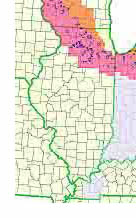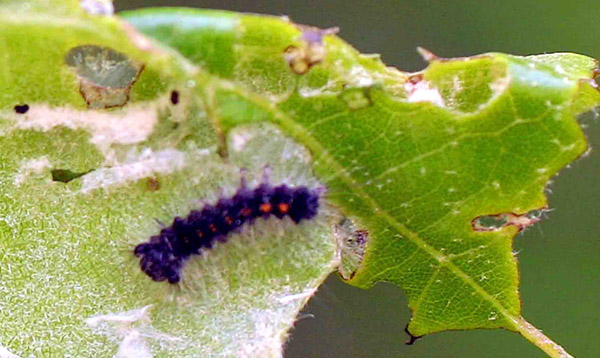Issue 2, May 1, 2009
Gypsy Moth
 Gypsy moth continues to spread and to increase in Illinois. Lake, Cook, DuPage, and McHenry counties are all under quarantine. Last year, there was heavy defoliation in these counties, particularly in the Downers Grove, Naperville, and Itasca areas. In addition, gypsy moth has been picked up in the last three years in most of the counties in the northern half of Illinois as well as in the St. Louis area. However, almost all of these catches have been individuals that do not usually indicate an infestation. A better idea of the leading edge of the infestation can be seen on the Slow-the-Spread map.
Gypsy moth continues to spread and to increase in Illinois. Lake, Cook, DuPage, and McHenry counties are all under quarantine. Last year, there was heavy defoliation in these counties, particularly in the Downers Grove, Naperville, and Itasca areas. In addition, gypsy moth has been picked up in the last three years in most of the counties in the northern half of Illinois as well as in the St. Louis area. However, almost all of these catches have been individuals that do not usually indicate an infestation. A better idea of the leading edge of the infestation can be seen on the Slow-the-Spread map.
Gypsy moth caterpillars hatch when common lilac, Syringa vulgaris, blooms. However, its main hosts, oaks, are typically just leafing out at that time. It is recommended to delay treatment until there is sufficient foliage expansion for sprays to have enough leaf surface to be effective.
Newly-hatched caterpillars are blackish and hairy. Once they have eaten their egg shells, they migrate to the top of the tree to feed. However, a few caterpillars stay on the leaves of lower branches, making it easier to detect infested trees. Binoculars are useful in detecting caterpillar activity at the top of trees. Within a week or so, the caterpillars grow and molt to a size and stage that is easier to detect. They are still black and hairy, but have obvious orange areas on their back. Later, they will develop the characteristic five pairs of blue and six pairs of red balls down their back.

Feeding continues through the spring. The caterpillars get progressively larger as the males go through five larval instars and the females go through six. In June to early July, the fully grown larvae approach two inches in length and migrate to pupate in protected areas. The adult moths emerge 10-14 days later.
Control Gypsy moth caterpillars with sprays of Bacillus thuringiensis kurstaki (Dipel, Thuricide), diflubenzuron (Dimilin), tebufenozide (Mimic, Confirm), or spinosad (Conserve). Because Gypsy moth larvae feed primarily at the top of trees that are frequently quite tall, it is important to use equipment that will spray that high.
Systemic insecticides are attractive for the control of Gypsy moth to avoid spraying insecticide so high into the air. However, imidacloprid, sold as Merit and several other brand names, is not effective in controlling caterpillars. Bidrin, sold as Inject-A-Cide B by Mauget, is effective but is highly toxic and requires annual root flare injection. Its packaging in injectors makes it less hazardous to the applicator. Another option is acephate (Lepitect) used as a soil injection. I have limited information on this material, but it should be effective. If you use Lepitect, let me know how successful you are in controlling Gypsy moths or other pests. It should take a week or two to move into the trees’ foliage and should provide about a month of control.--Phil Nixon
Author:
Phil Nixon